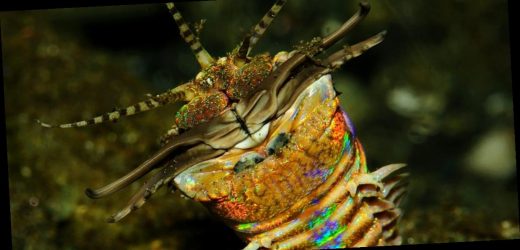- Bobbit worms explode out of tunnels on the ocean floor to ambush prey.
- According to a new study, these worms had 6-foot-long carnivorous ancestors that burrowed under the Pacific Ocean.
- Researchers found 20-million-year-old tunnels made by these prehistoric worms in Taiwan.
- Visit Business Insider's homepage for more stories.
Scientists in Taiwan noticed odd, L-shaped burrows in a set of rocks eight years ago. Since the rocks once sat on the Pacific Ocean floor, they thought the tunnels had been made by shrimp, or perhaps octopuses. But the shape and structure of the burrows didn't match those made by such creatures, and the mystery lingered.
Now, it's been solved: The architects behind the tunnels were 6-foot-long worms that lived about 20 million years ago, according to a study published this week. Fossil evidence helped the study authors figure out how these predators hunted and built their undersea lairs.
According to their research, the ancient marine worms would lay waiting under the sand for unsuspecting prey; then when fish passed by, the worms would lunge out of their burrows, snag the swimmers in their gaping maws, and drag the victims under the seafloor. Collapsed sand around the tunnel mouths indicated the prey thrashed fiercely in the worms' grip.
The researchers also concluded that the ancient worms are the ancestors of the modern-day bobbit worm, which catches prey in the same way.
"We knew that predatory worms have been around for hundreds of millions of years, but this is the first time we can actually see evidence of a behavior similar to the modern bobbit worms'," Ludvig Löwemark, a geoscientist from National Taiwan University in Taipei and one of the study's coauthors, told Insider.
Ancient rocks reveal how these huge worms lived
Löwemark's group found the burrows in sandstone rock layers in northeastern Taiwan. The rock formed between 5.3 and 23 million years ago, during an era called the Miocene.
They collected hundreds of burrow samples from Taiwan's Yehliu Geopark and Badouzi coast, then used those to identify the characteristics of trace fossils of the prehistoric worms' tunnels. A trace fossil is a geologic formation left by an animal that doesn't include remains of the animal itself.
Löwemark and his colleagues think the particular worms that built the burrows they found either abandoned them or died. The chance of finding a fossilized worm is very small anyway, Löwemark said, because its soft tissues would decompose quickly after death.
But the trace fossils can still show how the ancient worm hunted. The scientists named the fossil Pennichnus formosae, and determined that the worms built L-shaped burrows about an inch wide and up to 6.5 feet long.
The scientists also found evidence that the sand surrounding mouths of the burrows had been disturbed, suggesting that the predator that lived inside moved quickly to ambush prey, and also that the prey struggled in response.
This is the first time that scientists have found fossil evidence of an ambush predator living under the ocean floor.
"So far, similar trace fossils have not been reported from anywhere else on Earth," Löwemark said. Though he added that "this is likely explained by the fact that scientists didn't know what to look for until now."
Given that modern-day bobbit worms hunt the same way as these prehistoric creatures, the study authors hypothesized that they are related.
Further evidence for that idea came in the form of iron found in the rock, toward the top section of the ancient burrows. When bobbit worms build their burrows, they line them with mucus, and bacteria feeds on that mucus, leaving traces of iron behind. So the presence of iron in the trace fossils suggests that, much like bobbit worms, these ancient creatures sometimes had to re-build sections of their burrows with mucus.
An ambush predator
Löwemark thinks the worms that built the ancient burrows probably looked fairly similar to bobbit worms in appearance. Bobbit worms, however, can grow to lengths of 10 feet — much longer than the 6.5-foot-long burrows.
Bobbit worms live in the Atlantic, Indian, and Pacific Oceans. Only a tiny portion of their bodies protrude out of the sand. They snake their antennae into the water, wiggling them like tiny worms to attract nearby fish. When prey comes within striking distance, bobbit worms then explode out of their tunnels, grab the fish with sharp teeth, and sink back under. A bobbit worm's jaw, or pharynx, can snap a fish in half.
According to Löwemark, the bobbit worms' prehistoric ancestors probably had a similar diet. But it's not known for certain what happens after bobbit worms catch their prey and tug it under the sand (so the ancient worms' digestive process is a mystery too).
Luis Carrera-Parra and Sergio Salazar-Vallejo, ecologists at El Colegio de la Frontera Sur in Mexico, told Wired that they think bobbit worms sting animals with a narcotizing or killing toxin, so the prey "can be safely ingested — especially if they are larger than the worm — and then digested through the gut."
Bobbit worms don't pose a threat to humans, however.
Source: Read Full Article


